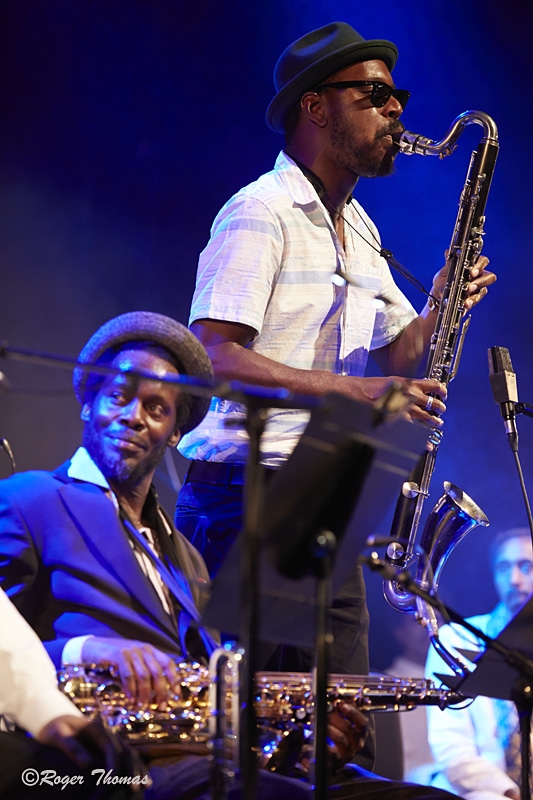Preview: John Coltrane's A Love Supreme | reviews, news & interviews
Preview: John Coltrane's A Love Supreme
Preview: John Coltrane's A Love Supreme
Unique fusion of spiritual and musical inspiration 're-envisioned' for 50th anniversary performance
John Coltrane’s album A Love Supreme, recorded 50 years ago next week, is second only to Miles Davis' Kind of Blue as a revered document of jazz recording.
The spiritual intensity of Coltrane’s tone, and the aspects of the prodigious technical accomplishments of the final years of his life, are what make the album so remarkable and enduring. Coltrane’s technical innovations include the sixteenth-note phrases which enabled him to explore large numbers of chord progressions in a solo, and the exploration of modes and scales as an alternative to the chord progressions of traditional jazz.
Coltrane was a gentle, humble man in his personal life, yet Miles Davis (in whose quintet he played for many years, including on Kind of Blue) said, “You have to remember, Coltrane was a very greedy man.” He wasn’t, it’s assumed, suggesting Coltrane was a hog at the tour motel buffet, or even alluding uncharitably to his various addictions (which contributed to a tragically early death), but was probably describing his appetite for creative and intellectual novelty, which was ravenous.

As a tribute to and celebration of this extraordinary event, flautist and composer Rowland Sutherland has arranged Coltrane’s work for his 15-piece Enlightenment Orchestra. With singer Cleveland Watkiss, saxophonists Steve Williamson (pictured) and Shabaka Hutchings, and pianist Pat Thomas, directed by Orphy Robinson from the xylosynth, the band has some of the most experienced players on the avant-garde jazz scene. Intriguingly, and apparently in an attempt to draw out the piece’s spiritual and world music inspiration (Coltrane drew broadly on Indian and West African spirituality), Sutherland has included parts for kora, tablas and bata drums, which aren’t in Coltrane’s quartet version. The direct referencing of Coltrane’s non-Western sources in this way could be brilliant or clumsy, but when the starting point is a piece so inspired, the performance will fascinate, at the very least, and has the potential to be a monumental event.
- A Re-Envisioning of John Coltrane’s A Love Supreme takes place on 9 December at Union Chapel
- Next page: listen to Coltrane's A Love Supreme on YouTube
more New music
 Album: Jonny Drop • Andrew Ashong - The Puzzle Dust
Bottled sunshine from a Brit soul-jazz team-up
Album: Jonny Drop • Andrew Ashong - The Puzzle Dust
Bottled sunshine from a Brit soul-jazz team-up
 theartsdesk on Vinyl: Record Store Day Special 2024
Annual edition checking out records exclusively available on this year's Record Store Day
theartsdesk on Vinyl: Record Store Day Special 2024
Annual edition checking out records exclusively available on this year's Record Store Day
 Album: Pearl Jam - Dark Matter
Enduring grunge icons return full of energy, arguably their most empowered yet
Album: Pearl Jam - Dark Matter
Enduring grunge icons return full of energy, arguably their most empowered yet
 Album: Paraorchestra with Brett Anderson and Charles Hazlewood - Death Songbook
An uneven voyage into darkness
Album: Paraorchestra with Brett Anderson and Charles Hazlewood - Death Songbook
An uneven voyage into darkness
 theartsdesk on Vinyl 83: Deep Purple, Annie Anxiety, Ghetts, WHAM!, Kaiser Chiefs, Butthole Surfers and more
The most wide-ranging regular record reviews in this galaxy
theartsdesk on Vinyl 83: Deep Purple, Annie Anxiety, Ghetts, WHAM!, Kaiser Chiefs, Butthole Surfers and more
The most wide-ranging regular record reviews in this galaxy
 Album: EMEL - MRA
Tunisian-American singer's latest is fired with feminism and global electro-pop maximalism
Album: EMEL - MRA
Tunisian-American singer's latest is fired with feminism and global electro-pop maximalism
 Music Reissues Weekly: Congo Funk! - Sound Madness from the Shores of the Mighty Congo River
Assiduous exploration of the interconnected musical ecosystems of Brazzaville and Kinshasa
Music Reissues Weekly: Congo Funk! - Sound Madness from the Shores of the Mighty Congo River
Assiduous exploration of the interconnected musical ecosystems of Brazzaville and Kinshasa
 Ellie Goulding, Royal Philharmonic Concert Orchestra, Royal Albert Hall review - a mellow evening of strings and song
Replacing dance beats with orchestral sounds gives the music a whole new feel
Ellie Goulding, Royal Philharmonic Concert Orchestra, Royal Albert Hall review - a mellow evening of strings and song
Replacing dance beats with orchestral sounds gives the music a whole new feel
 Album: A Certain Ratio - It All Comes Down to This
Veteran Mancunians undergo a further re-assessment and reinvention
Album: A Certain Ratio - It All Comes Down to This
Veteran Mancunians undergo a further re-assessment and reinvention
 Album: Maggie Rogers - Don't Forget Me
Rogers continues her knack for capturing natural moments, embracing a more live sound
Album: Maggie Rogers - Don't Forget Me
Rogers continues her knack for capturing natural moments, embracing a more live sound
 theartsdesk at Tallinn Music Week - art-pop, accordions and a perfect techno hideaway
A revived sense of civilisation thanks to dazzlingly diverse programming
theartsdesk at Tallinn Music Week - art-pop, accordions and a perfect techno hideaway
A revived sense of civilisation thanks to dazzlingly diverse programming
 Album: Lizz Wright - Shadow
Brilliant album from superlative vocalist
Album: Lizz Wright - Shadow
Brilliant album from superlative vocalist

Add comment